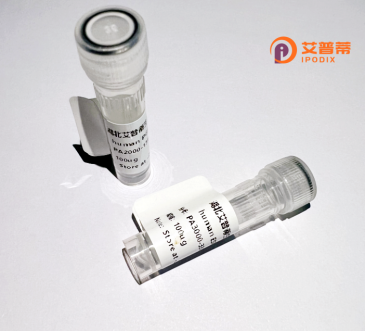
| 纯度 | >90%SDS-PAGE. |
| 种属 | Human |
| 靶点 | EIF2B3 |
| Uniprot No | Q9NR50 |
| 内毒素 | < 0.01EU/μg |
| 表达宿主 | E.coli |
| 表达区间 | 1-452aa |
| 氨基酸序列 | MEFQAVVMAVGGGSRMTDLTSSIPKPLLPVGNKPLIWYPLNLLERVGFEEVIVVTTRDVQKALCAEFKMKMKPDIVCIPDDADMGTADSLRYIYPKLKTDVLVLSCDLITDVALHEVVDLFRAYDASLAMLMRKGQDSIEPVPGQKGKKKAVEQRDFIGVDSTGKRLLFMANEADLDEELVIKGSILQKHPRIRFHTGLVDAHLYCLKKYIVDFLMENGSITSIRSELIPYLVRKQFSSASSQQGQEEKEEDLKKKELKSLDIYSFIKEANTLNLAPYDACWNACRGDRWEDLSRSQVRCYVHIMKEGLCSRVSTLGLYMEANRQVPKLLSALCPEEPPVHSSAQIVSKHLVGVDSLIGPETQIGEKSSIKRSVIGSSCLIKDRVTITNCLLMNSVTVEEGSNIQGSVICNNAVIEKGADIKDCLIGSGQRIEAKAKRVNEVIVGNDQLMEI |
| 分子量 | 76.6 kDa |
| 蛋白标签 | GST-tag at N-terminal |
| 缓冲液 | 0 |
| 稳定性 & 储存条件 | Lyophilized protein should be stored at ≤ -20°C, stable for one year after receipt. Reconstituted protein solution can be stored at 2-8°C for 2-7 days. Aliquots of reconstituted samples are stable at ≤ -20°C for 3 months. |
| 复溶 | Always centrifuge tubes before opening.Do not mix by vortex or pipetting. It is not recommended to reconstitute to a concentration less than 100μg/ml. Dissolve the lyophilized protein in distilled water. Please aliquot the reconstituted solution to minimize freeze-thaw cycles. |
以下是关于重组人EIF2B3蛋白的参考文献,按文献名称、作者和摘要内容进行概括:
---
1. **《Structure of the regulatory subunit of the eukaryotic initiation factor 2B complex》**
- **作者**:Adri Thomas et al.
- **摘要**:该研究解析了人源EIF2B复合体(含EIF2B3亚基)的晶体结构,揭示了其调控EIF2磷酸化的分子机制,通过重组表达技术获得了复合体并验证了EIF2B3在GTP结合中的关键作用。
2. **《Mutations in EIF2B3 impair translation initiation and cause hypomyelinating leukodystrophy》**
- **作者**:M.S. van der Knaap et al.
- **摘要**:文章报道了EIF2B3基因突变与儿童白质脑病(VWM)的关联,通过重组EIF2B3蛋白功能实验发现突变体导致复合体酶活性降低,从而引发翻译起始缺陷。
3. **《Functional characterization of the eukaryotic initiation factor 2B complex reconstituted from recombinant subunits》**
- **作者**:N.C. Wortham et al.
- **摘要**:研究利用重组人源EIF2B各亚基(包括EIF2B3)重组完整复合体,发现其GEF(鸟苷酸交换因子)活性依赖亚基间协同作用,为药物靶向调控提供了实验模型。
4. **《Dynamic phosphorylation of the C-terminal domain of EIF2B by CK2 regulates its activity》**
- **作者**:Chris G. Proud et al.
- **摘要**:通过重组EIF2B3蛋白与激酶共表达实验,证明其C端结构域被CK2磷酸化修饰后增强EIF2B复合体活性,揭示了翻译调控的翻译后修饰机制。
---
这些文献覆盖了EIF2B3的结构解析、疾病相关突变、重组表达技术及功能调控研究,适用于分子机制探索与疾病模型构建的参考。
Recombinant human EIF2B3 protein is a key component of the eukaryotic translation initiation factor 2B (EIF2B), a heteropentameric complex critical for protein synthesis regulation. EIF2B acts as a guanine nucleotide exchange factor (GEF), catalyzing the exchange of GDP for GTP on eukaryotic initiation factor 2 (EIF2), a step essential for recycling EIF2 during translation initiation under stress conditions. Among EIF2B’s five subunits (α–ε), the γ-subunit (EIF2B3) plays a structural and catalytic role, contributing to the stability and enzymatic activity of the complex. Dysregulation of EIF2B is linked to cellular stress responses, including the integrated stress response (ISR), and mutations in EIF2B genes are associated with Vanishing White Matter disease (VWM), a fatal leukodystrophy. Recombinant EIF2B3 is typically produced in heterologous systems like *E. coli* or mammalian cells, enabling studies on its biochemical properties, interactions, and mechanisms in health and disease. Its recombinant form allows researchers to explore the functional consequences of VWM-associated mutations, screen potential therapeutics, and dissect molecular pathways involving translational control. This tool has become vital for understanding EIF2B’s role in cellular homeostasis and neurodegenerative disorders.
×